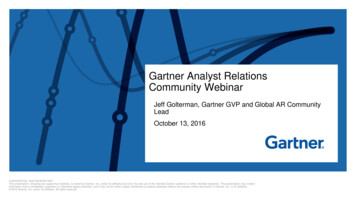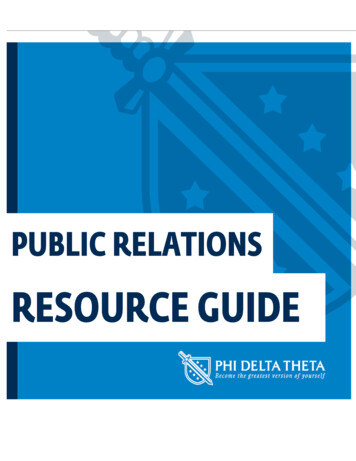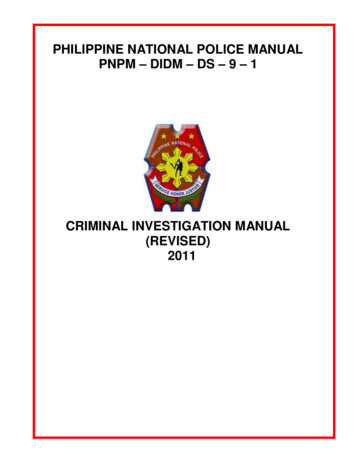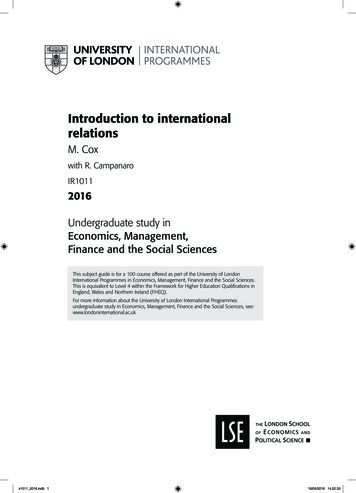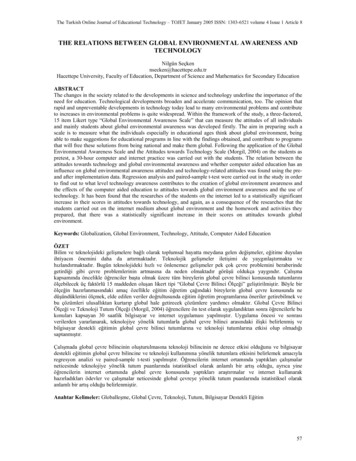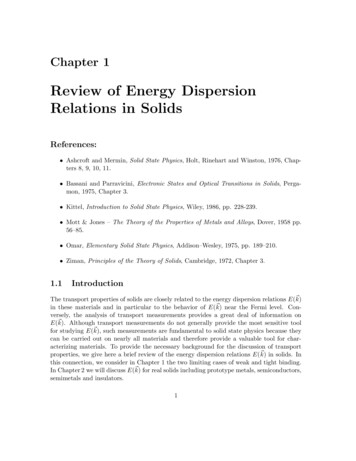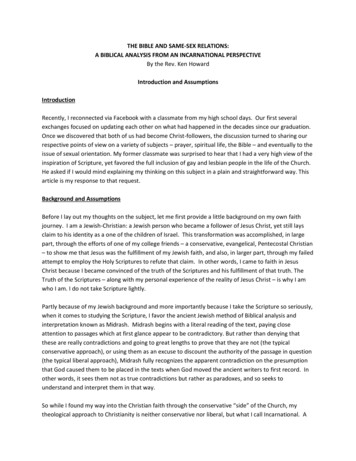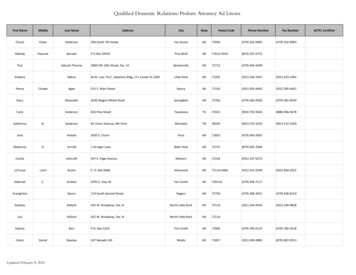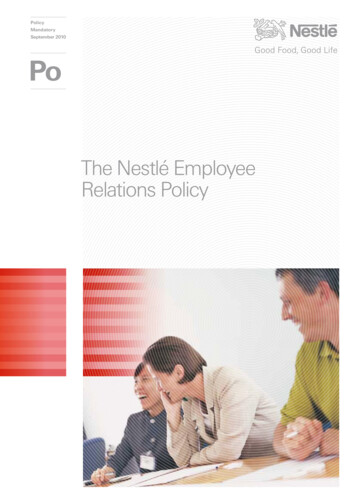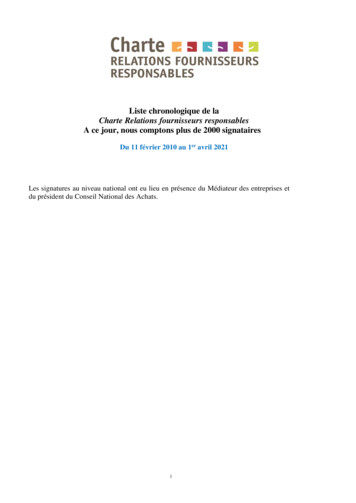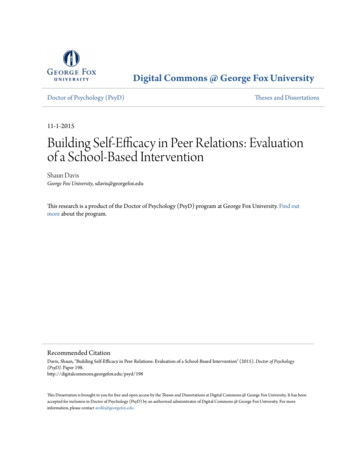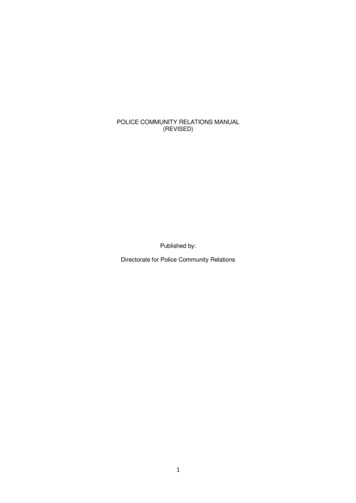
Transcription
POLICE COMMUNITY RELATIONS MANUAL(REVISED)Published by:Directorate for Police Community Relations1
2
PCR MANUALTABLE OF CONTENTSPage No.SILG/Chairman NAPOLCOM MessageiC, PNP’s MessageiiForewordiiiAcknowledgementCHAPTER I – DIRECTION SETTING1Important Policy Statement and Legal BasisTo Serve and Protect: The Principal Paradigm of PolicingA. VisionB. MissionC. Functions34566CHAPTER II – PCRism: A COMMUNITY ORIENTED POLICING IDEOLOGYA. Community PolicingB. Activities in Community PolicingC. Important Basic Principles of Community Policing81116CHAPTER III – OVERVIEW OF THE PNP REVISED PCR MANUALA.B.C.D.E.Brief IntroductionTwo-Prong Strategy of the Revised PCR Master PlanEvolution of PCR Policy PlansPCR in Community Oriented Policing System (COPS)Doctrine of Reciprocal Responsibility1919232626CHAPTER IV – THE PCR TEAMA.B.C.D.The PCR Team CompositionThe Attributes of a PCR ManThe Area VisitThe House Visit or Neighborhood Partnership330313233
E. The Strategic Position for Neighborhood PartnershipF. The Power of Good Grooming and Dressing3435CHAPTER V – PUBLIC roductionPublic Information and Perception ManagementSources of Public InformationFunctions of Public Information OfficeMulti-Media RelationsDesignation of PIO/SpokespersonResponsibility of the Unit CommanderDuties of the PIORoles of Public Information OfficerIn the Absence of the PIOMedia Accreditation ProcessHow to Deal with the MediaReleasing Information to the MediaDealing with the Media During Crisis/Emergency SituationsDealing with Bad NewsWriting the News ReleasePublic Information: Techniques, Approaches and StrategiesProcedures in Preparing Effective Public Information for Programsand ProjectsS. Best Practices in Public InformationT. PTER VI – COMMUNITY AFFAIRS AND troductionFunctionObjectivesGeneral Guidelines in OrganizingArea/Sector Selection PhaseEntry Into the CommunityProjecting a Lifestyle in Community OrganizingSocial Investigation/Community StudyGuide for Community StudyIntegrationContact Building/Spotting Potential LeadersCore Group FormationTraining and MobilizationCommunity OrganizationCommunity InterventionCommunity Safety & Security AssistanceForeign Nationals and Indigenous CommunitiesSpecial Concerns4737373747575757676767677777878798081
CHAPTER VII – The Information Operations Research ls in Information OperationInformation DefinedInformation Operation DefinedApplication and Concept of Information OperationsFunctional Sections of Information Operations Research CenterIntelligence CyclePublic Affairs and Information OperationInformation SystemsTemplating the Information Operation PlanInformation Operation Template9292939395969697989899CHAPTER VIII – GENDER AND DEVELOPMENT (GAD)A. Gender Mainstreaming as a Strategy for Implementing theMagna Carta of WomenB. Police Officers as Advocates of Development in GenderC. The Difference Between Sex and GenderD. Gender and DevelopmentE. GAD’s Focus on Women’s Place in DevelopmentF. Gender MainstreamingG. Policy Imperatives for Gender MainstreamingH. GAD PlanI. End Goal of GAD MainstreamingJ. Movers of GADK. Strategies for Gender Mainstreaming of Gender-ResponsiveProject/activitiesL. The GAD Mainstreaming ContinuumM. The Four Entry Points of GAD MainstreamingN. Proposed Strategies for GAD 28131CHAPTER IX – Foreign Nationals and Cultural Minorities Special ConcernsA.B.C.D.E.F.G.SALAAM Police Center and Counter RadicalizationFunctionsImportant TerminologiesImplementing Guidelines and Operations of SPCRegular Activities Conducted by SPCCounter Radicalization and DeradicalizationForeign Nationals’ Special Policing Concerns133133135136136137138CHAPTER X – Applying PCR In Police OperationsA. PCR in the QUAD Concept of Police Operations5141
B. The Integrated City/Municipal Police Stations PCR OperationsC. The Barangay Peacekeeping PCR OperationsD. The Formation and Operationalization of the BPAT Principles andGuidelinesE. Organization and Operationalization of the BPATF. BPKO ApproachG. Organizing the Barangay Peacekeeping Action Teams (BPATs)H. Information Operation applied to cushion the Impact ofLaw Enforcement during Labor DisputesI. PCR and Information Operations during Rallies, Demonstrationand CDMJ. Demolitions, Injunctions and Other Similar OrdersK. PCRizing Checkpoint OperationsL. Hostage Situation and Crisis Management’s PCR ComponentM. The Police-Community Relation’s Approach inInternal Security OperationN. ―Winning the Community‖ PTER XI – INDEXESA.B.C.D.E.F.G.Guidelines in Establishing Media Relations (DOs and DON’Ts)Guidelines in Writing News ReleasesAnswering Interview QuestionsAppearance in a Television InterviewConducting Yourself in a TV InterviewPNP GAD Mainstreaming Effort Self-Assessment FormOrganizing and Mobilizing Families, Women and Children181184186188191193196ACRONYMS and MEANINGS205REFERENCES2066
Republic of the PhilippinesDepartment of the Interior and Local GovernmentNATIONAL POLICE COMMISSION(Pambansang Komisyon ng Pulisya)371 Gil J Puyat Ave. Makati CityMESSAGEI would like to congratulate the PNP Directorate for Police Community Relations under thestewardship of Police Director Rommel DF Heredia for this informative and valuable PoliceCommunity Relations (PCR) Manual.As the Philippine National Police gears its thrust towards a more active implementation ofcommunity-oriented policing, it is imperative that our men be guided accordingly in this discipline.We know that a strong relationship between the police and the community is a key factor inattaining peace and security. However, for the PNP to establish this kind of partnership, it must beable to build trust, which is basically dependent on the community’s level of satisfaction on theperformance of the police. Hand in hand therefore with mastering effective police communityrelations, the police must undergo total transformation to be more effective in carrying out itsmandate.Through effective police community relations, the citizens can learn about their roles incrime prevention and what to expect from the police. In the same way, the police can betterunderstand the people they serve and execute strategies to better address peace and order issues.One of the prime objectives of police community relations is to establish a collaborative partnershipthat can analyze problems, design and implement solutions that are truly community-based.This Manual is truly indispensable as it guides and directs PCR officers in making all their PCRundertakings successful.JESSE M ROBREDOSecretary, DILG andChairman, NAPOLCOM7
HEADQUARTERSPhilippine National PoliceOFFICE OF THE CHIEF, PNPNHQ PNP Building, Camp Crame, Quezon CityManila PhilippinesMESSAGE“Pulis Ako, Pulis Nyo Po”.A synergistic partnership between the community and the Philippine National Police isessential if crime reduction and quality of life are to improve. Thus, both mutual and supportiverelationships are vital in increasing the law enforcers’ effectiveness in enforcing the law, reducingcrime and maintaining peace.This partnership can be further strengthened by initiating programs to make the communityfeel safe with the police. When every citizen feels safe in the community, trust and confidence in thepolice is regained. Thus, it will be easier to solicit their support in all police programs to attaingenuine peace and security. In so doing, the PNP shall be a more accessible and indispensablepartner of the community in providing more efficient and effective services.The initiative of the Directorate for Police Community Relations (DPCR) under the leadershipof Police Director Rommel DF Heredia to revise the PNP Police Community Relations Manual isindeed very timely. This manual is critical and essential as this will guide PCR officers on how to plan,implement and realize police community relations endeavors.To all the men and women of DPCR who made this manual possible, please accept myrespect and admiration truly a glaring example of SERBISYONG MAY PAGKUKUSA Congratulations!NICANOR A BARTOLOME, CSEEPolice Director GeneralChief, PNP8
HEADQUARTERSPhilippine National PoliceDIRECTORATE FOR POLICE COMMUNITY RELATIONSNHQ PNP, Camp Crame, Quezon CityManila, PhilippinesFOREWORDThe Philippine National Police has shifted its thrust from traditional policing to communityoriented policing as it believes that peace and order is a shared responsibility of the police and thecommunity.This philosophy requires that the relationship of the police and the community should beharmonious. As the community relies upon the police to serve and protect, the police relies on thecommunity for its support and cooperation in order to effectively carry out its mandate.Communities must be actively involved in crime reduction, prevention and problem solving. To getthem involved, proper coordination and communication is essential. When communication and trustdeteriorate, tension is built which undermines their shared goals of a peaceful and secureenvironment.This is the ideal of the existence of the Directorate for Police Community Relations (DPCR) –to bridge the police and the community.The Manual which presents a revitalized PCR Master Plan, was designed to guide PCROfficer on how to manage police community relations projects best suited for their localities. Thismaster plan which serves as the National PCR Programs Strategy of the PNP also gives emphasis oncapacity building and skill development in support of the PNP Integrated Transformation PlanMore importantly, it provides guidelines in the different aspects of PCR: Public Information,Community Affairs and Mobilization, Information Operation, Gender and Development and ForeignNationals’ and Cultural Minorities’ Special Concerns By and large, this manual will serve as a vitalreference in the application of police community relations in regular police operations, both at thestrategic and tactical level.ROMMEL DF HEREDIAPolice DirectorDirector, DPCR9
ACKNOWLEDGEMENTWe wish to commend PCSUPT GIL J HITOSIS who took the lead, supervisedand provided necessary information in completing this Manual.We would like also to acknowledge the efforts provided by PCSUPTBENJAMIN B MAGALONG - Executive Officer; PSSUPT ROLAND A VICENTE Chief, Plans and Programs Division; PSSUPT EFREN PEREZ - Chief, PublicInformation Division; PSSUPT JESSIE J STO DOMINGO - Chief, Community AffairsDivision; PSSUPT JONATHAN V ABLANG - Chief, Information and Operations andResearch Center; PSSUPT MA ASUNCION DLP PLACINO - Chief, Family, JuvenileGender and Development Division; PSSUPT NICKSON MUKSAN - Chief, SalaamPolice Center.We would like also to recognize the assistance given by PSUPT DAVID NIÑOL RABAYA, PSUPT JOSELITO L CLARITO, PSUPT AILEEN G PADAOAN, PCINSPNIEVES A DE LA PEÑA, PCINSP MA TERESA P VILLA, PCINSP LORENZO PBERNAS, PINSP RIQUE A BAUSA, SPO1 Elvis C Arellano, SPO1 Eleanor C Mateo,NUP Perlita P Herminado, NUP Irma Villa, NUP Rex N Usana, and NUP Rigel PaoloR Ilac.Your efforts are well appreciated.The Editorial Staff10
CHAPTER IDirection SettingPolice-Community Relations is a slowly evolving policing system that is beingadopted by police organizations worldwide. This policing system can be equated withdiplomacy such that even the subjects of policing actions view the system as themost acceptable form of police-community interaction to ferret out crimes, ensurepublic safety, or maintain peace and order.Edward Davis, the Chief of Police of California from 1969-1978, postulatedthat the ability of the police to perform their duties is dependent upon public approvalof police existence, actions, behavior, and the ability of the police to secure andmaintain public respect. The police feels public acceptance when its existence,actions and behavior are not routinely criticized, maligned, or branded withunacceptable languages or treated with synonymous situation that can already beconsidered as a hostile environment. The need for public acceptance is imperativeas it will truly be difficult for police officers to work under a stressful scenario as it canalso spark human emotions and cultivate friction points.Michael P. Tremoglie a former Philadelphia police officer and a freelancewriter quoted in his article ―Police and Public Opinion‖ that Police work is intrinsicallyreactive. A police officer is never called when things are going well. They are onlycalled when there is a problem-usually a critical one. It is only natural that policereceives criticism for what they do. After all, any occupation charged with theresponsibility of bringing order out of chaos or enforcing the rules like - baseballumpires, building inspectors, referees, etc. - are controversial positions.Police officers have only a set of narrowly defined objectives- and a body oflaw that is continually subjected to revision and interpretation - to guide them. Giventhe urgency of the plight in which police usually find themselves, it is a wonder thatthe police are able to perform their duties with as little controversy as they do. Thereis no question that many times police are forced to act intuitively. Yet, this is not thecharacterization of police that is rendered to the public. Police work is rarelypresented to the public in a positive light. The mainstream liberal media seem tothink that police work is not entertaining unless it is in a dilemma.The thousands of acts each day that police officers perform are rarelyrecognized.Groups that profit from police controversies begin campaignsdemonizing police. Their propaganda campaign is used to discredit the police andsimple errors bring them to the front pages of newspapers.Public perception of the police becomes disfigured. Experts define publicperception as t
J. Integration 76 K. Contact Building/Spotting Potential Leaders 76 L. Core Group Formation 77 M. Training and Mobilization 77 . that can analyze problems, design and implement solutions that are truly community-based. This Manual is truly indispensable as it guides and directs PCR officers in making all their PCR undertakings successful. JESSE M ROBREDO Secretary, DILG and Chairman .
